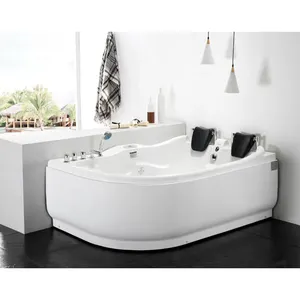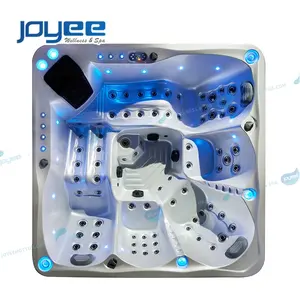Introduction
Imagine transforming your bathroom into a personal spa, where relaxation and rejuvenation are just a step away. Welcome to the world of massage tubs, a luxurious addition to any home that offers a plethora of physical and mental health benefits. From easing aches and pains to promoting better sleep, these tubs use the principles of hydrotherapy to create a soothing, spa-like experience. In this article, we delve into the science behind hydrotherapy, explore the different types of massage tubs, and highlight the top benefits of owning one. We also guide you on how to choose the right massage tub for your needs, considering factors like size, design, features, and maintenance costs.
Understanding Massage Tubs
A massage tub, also known as an air tub, is a luxurious addition to any bathroom. Initially developed for therapeutic use in hospitals, these tubs use an air blower and strategically placed jets to create a soothing, spa-like experience. The jets are positioned to target your lower back, hips, and legs, providing a relaxing massage. Some models even warm the air to body temperature for added comfort. Air tubs are typically constructed with a double-walled design for thermal insulation, ensuring longer, warmer soaks. They also come with a water-resistant remote control for easy adjustment of motor speed and functionality.
The Science Behind Hydrotherapy
Hydrotherapy, or aquatic therapy, involves performing gentle exercises in water. Physical therapists leverage the unique principles of water, such as buoyancy, hydrostatic pressure, cohesion, and viscosity, to assist patients in activities that might be challenging on land. Hydrotherapy eases pressure on joints, enabling patients to move comfortably and freely. It's particularly beneficial for those who find land-based exercises too painful. Hydrotherapy also offers cardiovascular benefits without increased stress on joints, improves endurance, and enhances circulation.
Different Types of Massage Tubs
Our platform offers a wide range of massage tub experiences. Each type is unique and therapeutic, catering to different preferences. You can choose from the simple luxury of a soaking bath, the gentle sensation of bathing in a forest stream, the invigorating deep-tissue massage of a whirlpool, the light full-body thermo-air massage, or a combination. With a vast selection of tub models and multiple configurations, we cater to your specific hydrotherapy needs.
Top Benefits of a Massage Tub
Massage tubs, also known as hot tubs, offer numerous health benefits. They provide relief from aches and pains by using hot water to apply chemical, mechanical, and thermal massages to the body, improving blood circulation and relieving tension in muscles. Hydrotherapy in massage tubs can also help manage chronic back pain. Furthermore, they offer stress relief, creating a sanctuary away from daily life's turmoil. Regular use can improve sleep quality, encourage weight loss, and even aid in managing conditions like diabetes and heart disease. They also provide temporary relief from arthritic joint pain and symptoms of fibromyalgia.
Physical Health Benefits
Hydrotherapy, often facilitated by massage tubs, offers significant physical health benefits. It aids in recovery from injuries, particularly to joints like knees, hips, shoulders, neck, back, feet, and ankles. It's also beneficial pre-and-post joint replacement surgery, and for conditions like Fibromyalgia and severe joint pain. Hydrotherapy improves endurance, cardiovascular health, mobility, balance, and strength, all without increasing stress on joints. It reduces muscle and joint soreness, enhances circulation, and improves muscle tone. Importantly, it reduces the chances of re-injury, allowing patients to recover safely and effectively.
Mental Health Benefits
Massage tubs can offer significant mental health benefits. The soothing effect of hydrotherapy can help reduce anxiety and promote a sense of calm. It's a form of mindful relaxation, where you can focus on the sensation of the water jets, similar to mindful breathing exercises. This can help to reduce negative thinking and anchor you in the present moment. The warm water and massaging jets can also help to relieve stress, promoting a sense of wellbeing and relaxation.
Enhanced Sleep Quality
Relaxing in a massage tub can significantly enhance your sleep quality. The warm water raises your body temperature, and as you exit and cool down, your brain signals it's time for sleep, helping you fall asleep faster. Moreover, studies have found that warm water baths before bed can reduce sleep interruptions. The hydrotherapy effects, combined with a gentle massage from the tub's jets, can lead to a deeper, more restful sleep. This is particularly beneficial for those who struggle with insomnia or disrupted sleep patterns.
Choosing the Right Massage Tub for You
Choosing the right massage tub involves considering the size of your bathroom and the tub configuration. Massage tubs come in various sizes and styles, including drop-in and alcove tubs. You also need to decide on a massage system, with options like whirlpools, air tubs, and combination systems. Enhanced features such as the number of jets, chromatherapy, energy efficiency, and cleanliness systems can further enhance your bathing experience.
Considerations for Size and Design
When choosing a massage tub, considering the size of your bathroom is crucial. Massage tubs come in various sizes, so measure your bathtub space to determine the best fit. Also, consider the tub's weight to ensure your floor can support it, and the volume of water it will use. If you live in an area with water shortages, a smaller model might be more suitable. A deep massage tub may use more water than your hot water heater can hold, so consider installing a second heater or an in-line bath heater.
Understanding Features and Functions
Massage tubs, such as whirlpool tubs, offer an invigorating hydro-massage experience at home, using high-powered water jets. Most models allow the mixing of air into the water for an effervescent experience. On the other hand, air bath tubs provide a gentler experience, circulating thousands of tiny warm air bubbles from small holes in the tub. This results in a quiet, self-draining, and easy-to-clean tub, with a heating unit to keep your water warm throughout your bath.
Investment and Maintenance Costs
The cost of maintaining a massage tub depends on its type, materials, and functionality. High-end models may be more expensive initially but can save money in the long run due to their quality and energy efficiency. Installation costs vary based on location, size, and complexity. Average monthly electricity costs for well-insulated tubs can range from $25 to $40. Basic water care costs around $20 per month, but upgrading your water system can save money and maintenance time in the future. Regular maintenance is required to keep your tub in top condition.
Conclusion
In conclusion, a massage tub is more than just a luxurious addition to your bathroom. It's a gateway to improved physical and mental health, offering relief from chronic pain, stress, and sleep disorders. The science of hydrotherapy, combined with the advanced features of modern massage tubs, creates a therapeutic experience right in your home. Whether you prefer the invigorating massage of a whirlpool or the gentle sensation of an air bath, there's a tub to cater to your specific needs. However, choosing the right one requires careful consideration of factors like size, design, features, and maintenance costs. With the right choice, you can transform your daily bathing routine into a rejuvenating spa experience, promoting overall wellbeing and enhancing your quality of life.










































 浙公网安备 33010002000092号
浙公网安备 33010002000092号 浙B2-20120091-4
浙B2-20120091-4